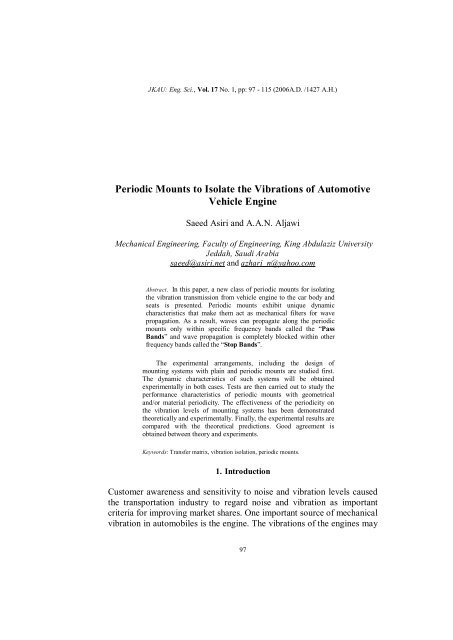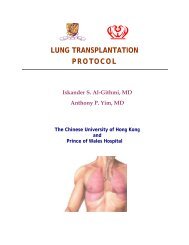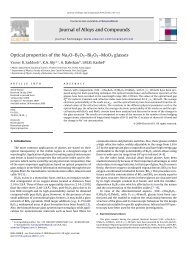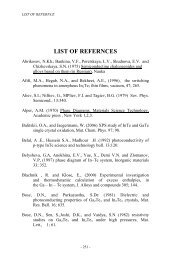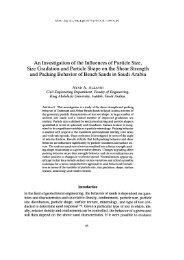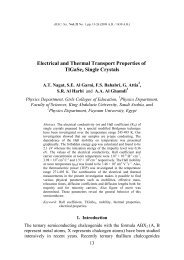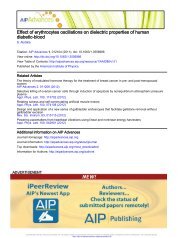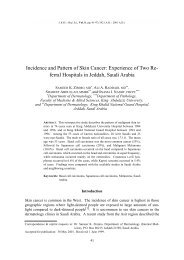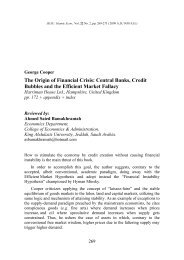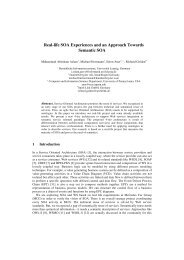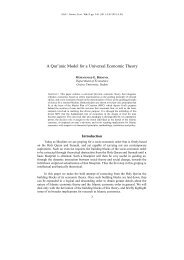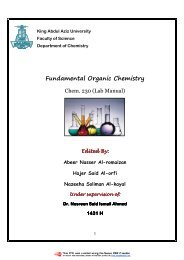Periodic Mounts to Isolate the Vibrations of Automotive Vehicle Engine
Periodic Mounts to Isolate the Vibrations of Automotive Vehicle Engine
Periodic Mounts to Isolate the Vibrations of Automotive Vehicle Engine
Create successful ePaper yourself
Turn your PDF publications into a flip-book with our unique Google optimized e-Paper software.
JKAU: Eng. Sci., Vol. 17 No. 1, pp: 97 - 115 (2006A.D. /1427 A.H.)<br />
<strong>Periodic</strong> <strong>Mounts</strong> <strong>to</strong> <strong>Isolate</strong> <strong>the</strong> <strong>Vibrations</strong> <strong>of</strong> Au<strong>to</strong>motive<br />
<strong>Vehicle</strong> <strong>Engine</strong><br />
Saeed Asiri and A.A.N. Aljawi<br />
Mechanical <strong>Engine</strong>ering, Faculty <strong>of</strong> <strong>Engine</strong>ering, King Abdulaziz University<br />
Jeddah, Saudi Arabia<br />
saeed@asiri.net and azhari_n@yahoo.com<br />
Abstract. In this paper, a new class <strong>of</strong> periodic mounts for isolating<br />
<strong>the</strong> vibration transmission from vehicle engine <strong>to</strong> <strong>the</strong> car body and<br />
seats is presented. <strong>Periodic</strong> mounts exhibit unique dynamic<br />
characteristics that make <strong>the</strong>m act as mechanical filters for wave<br />
propagation. As a result, waves can propagate along <strong>the</strong> periodic<br />
mounts only within specific frequency bands called <strong>the</strong> “Pass<br />
Bands” and wave propagation is completely blocked within o<strong>the</strong>r<br />
frequency bands called <strong>the</strong> “S<strong>to</strong>p Bands”.<br />
The experimental arrangements, including <strong>the</strong> design <strong>of</strong><br />
mounting systems with plain and periodic mounts are studied first.<br />
The dynamic characteristics <strong>of</strong> such systems will be obtained<br />
experimentally in both cases. Tests are <strong>the</strong>n carried out <strong>to</strong> study <strong>the</strong><br />
performance characteristics <strong>of</strong> periodic mounts with geometrical<br />
and/or material periodicity. The effectiveness <strong>of</strong> <strong>the</strong> periodicity on<br />
<strong>the</strong> vibration levels <strong>of</strong> mounting systems has been demonstrated<br />
<strong>the</strong>oretically and experimentally. Finally, <strong>the</strong> experimental results are<br />
compared with <strong>the</strong> <strong>the</strong>oretical predictions. Good agreement is<br />
obtained between <strong>the</strong>ory and experiments.<br />
Keywords: Transfer matrix, vibration isolation, periodic mounts.<br />
1. Introduction<br />
Cus<strong>to</strong>mer awareness and sensitivity <strong>to</strong> noise and vibration levels caused<br />
<strong>the</strong> transportation industry <strong>to</strong> regard noise and vibration as important<br />
criteria for improving market shares. One important source <strong>of</strong> mechanical<br />
vibration in au<strong>to</strong>mobiles is <strong>the</strong> engine. The vibrations <strong>of</strong> <strong>the</strong> engines may<br />
97
S. Asiri and A. A.N. Aljawi 98<br />
cause structural failure, malfunction <strong>of</strong> o<strong>the</strong>r parts, or discomfort <strong>to</strong><br />
passengers because <strong>of</strong> high level noise and vibrations. The mounts <strong>of</strong> <strong>the</strong><br />
engines act as <strong>the</strong> transmission paths <strong>of</strong> <strong>the</strong> vibrations transmitted from<br />
<strong>the</strong> excitation sources <strong>to</strong> <strong>the</strong> body <strong>of</strong> <strong>the</strong> vehicle and passengers.<br />
Therefore, proper design and control <strong>of</strong> <strong>the</strong>se mounts are essential <strong>to</strong> <strong>the</strong><br />
attenuation <strong>of</strong> <strong>the</strong> vibration <strong>of</strong> platform structures. To improve vibration<br />
resistant capacities <strong>of</strong> engine mounting systems, vibration control<br />
techniques may be used. For instance, some passive and semi-active<br />
dissipation devices may be installed at mounts <strong>to</strong> enhance vibration<br />
energy absorbing capacity. Analysis and design <strong>of</strong> such mounts are <strong>the</strong><br />
main objectives <strong>of</strong> this paper.<br />
In general, vibration isolation can be achieved partially with <strong>the</strong> use<br />
<strong>of</strong> many types <strong>of</strong> compliant connections between <strong>the</strong> vibration source and<br />
<strong>the</strong> device <strong>to</strong> be protected. The classical approach <strong>to</strong> design isolation<br />
systems focuses primarily on <strong>the</strong> properties <strong>of</strong> those compliant plain<br />
mounts without regard <strong>to</strong> <strong>the</strong> effect <strong>of</strong> using <strong>the</strong> periodicity concept on<br />
<strong>the</strong> isolated device.<br />
The study <strong>of</strong> periodic structures has a long his<strong>to</strong>ry. Wave<br />
propagation in periodic systems related <strong>to</strong> crystals, optics, and <strong>the</strong> like<br />
[1]<br />
has been investigated for approximately 300 years. Brillouin<br />
developed <strong>the</strong> <strong>the</strong>ory <strong>of</strong> periodic structures for solid state applications<br />
and <strong>the</strong>n, in <strong>the</strong> early seventies, <strong>the</strong> <strong>the</strong>ory was extended <strong>to</strong> <strong>the</strong> design <strong>of</strong><br />
mechanical structures [2, 3] . Since <strong>the</strong>n, <strong>the</strong> <strong>the</strong>ory has been extensively<br />
applied <strong>to</strong> a wide variety <strong>of</strong> structures such as spring-mass systems [4] ,<br />
periodic beams [2, 5-8] stiffened plates [7-8] , ribbed shells [7] and space<br />
structures. Examples <strong>of</strong> such structures are found in many engineering<br />
applications. These include bulkheads, helicopter drive shaft [9] , airplane<br />
fuselages, vehicle engine mounting systems [10] , and helicopter gearbox<br />
supporting system [11] . Each such structure has a repeating set <strong>of</strong><br />
stiffeners which are placed at regular intervals. Sackman et al. [12]<br />
presented a layered notch filter device in passive mode that is limited<br />
only for high-frequency vibrations. Such Filter which was developed<br />
<strong>the</strong>oretically based on Floquet <strong>the</strong>ory is a periodically layered stack <strong>of</strong><br />
alternating materials with widely different densities and stiffnesses.<br />
Using modal analysis Szefi [13] examined <strong>the</strong> effects <strong>of</strong> three-dimensional<br />
elasticity on periodically layered isola<strong>to</strong>rs in compression.
99<br />
<strong>Periodic</strong> <strong>Mounts</strong> <strong>to</strong> <strong>Isolate</strong> <strong>Vibrations</strong><br />
<strong>Periodic</strong> rods in <strong>the</strong>ir passive mode <strong>of</strong> operation exhibit unique<br />
dynamic characteristics that make <strong>the</strong>m act as mechanical filters for wave<br />
propagation. As a result, waves can propagate along <strong>the</strong> periodic rods<br />
only within specific frequency bands called <strong>the</strong> “Pass Bands” and wave<br />
propagation is completely blocked within o<strong>the</strong>r frequency bands called<br />
<strong>the</strong> “S<strong>to</strong>p Bands”. The spectral width and location <strong>of</strong> <strong>the</strong>se bands are<br />
fixed for 1-D passive periodic structure, but tunable in response <strong>to</strong> <strong>the</strong><br />
structural vibration for active periodic structures [14, 15] . Asiri et al. [15]<br />
presented a tunable mechanical filter with active periodic rods in a quasistatic<br />
manner, <strong>to</strong> isolate <strong>the</strong> wave propagation <strong>of</strong> longitudinal vibration. To model<br />
<strong>the</strong> tunable mechanical filter, <strong>the</strong> spectral finite element analysis and<br />
transfer matrix method [14] will be used <strong>to</strong> analyze <strong>the</strong> hybrid periodic rod<br />
and determine <strong>the</strong> propagation parameter, μ which indicates <strong>the</strong> regions<br />
<strong>of</strong> s<strong>to</strong>p bands and pass bands.<br />
This paper is organized in four sections. In Section 1, a brief introduction<br />
is given. Section 2 presents <strong>the</strong> <strong>the</strong>oretical background <strong>of</strong> passive mounts<br />
and Section 3 demonstrates <strong>the</strong> performance characteristics <strong>of</strong> <strong>the</strong> mounts<br />
alone as well as <strong>the</strong> mounts and engine system assembly. Comparisons<br />
between <strong>the</strong> <strong>the</strong>oretical and experimental characteristics are also<br />
presented in Section 3. Section 4 summarizes <strong>the</strong> findings and <strong>the</strong><br />
conclusions <strong>of</strong> <strong>the</strong> present study as well as <strong>the</strong> direction for future<br />
research.<br />
2.1 Overview<br />
2. Theoretical Modeling <strong>of</strong> <strong>Periodic</strong> <strong>Mounts</strong><br />
In this section, <strong>the</strong> emphasis is placed on studying <strong>the</strong> dynamics <strong>of</strong><br />
one-dimensional periodic mounts in <strong>the</strong>ir passive mode <strong>of</strong> operation. The<br />
dynamics <strong>of</strong> one-dimensional periodic mounts are determined using <strong>the</strong><br />
transfer matrix method. The basic characteristics <strong>of</strong> <strong>the</strong> transfer matrices<br />
<strong>of</strong> periodic mounts are presented and related <strong>to</strong> <strong>the</strong> physics <strong>of</strong> wave<br />
propagation along <strong>the</strong>se mounts. The methodologies for determining <strong>the</strong><br />
pass and s<strong>to</strong>p bands as well as <strong>the</strong> propagation parameters are presented.
2.2 Dynamics <strong>of</strong> Passive <strong>Mounts</strong><br />
2.2.1 General<br />
S. Asiri and A. A.N. Aljawi 100<br />
Consider <strong>the</strong> generic one-dimensional periodic mount shown in Fig.<br />
1. The undamped dynamics <strong>of</strong> <strong>the</strong> k th cell are determined from <strong>the</strong><br />
following finite element expression:<br />
⎡MLL MLR⎤⎧⎪u��L ⎫ k ⎪ ⎡KLL KLR<br />
⎤⎧⎪uL<br />
⎫ F<br />
k ⎪ ⎧⎪ L ⎫ k ⎪<br />
⎢<br />
MRL M<br />
⎥⎨ ⎬+ RR u<br />
⎢<br />
R K k RL K<br />
⎥⎨<br />
⎬= ⎨ ⎬<br />
⎣ ⎦⎪⎩ �� ⎪⎭ ⎣ RR⎦⎪⎩uR F<br />
k⎪⎭ ⎪⎩ Rk⎪⎭<br />
where Mij and Kij are appropriately partitioned matrices <strong>of</strong> <strong>the</strong> mass and<br />
stiffness matrices. Also, u and F define <strong>the</strong> deflection and force vec<strong>to</strong>rs<br />
with subscripts Li and Ri denoting <strong>the</strong> left and right sides <strong>of</strong> <strong>the</strong> kth cell.<br />
Cell 1 Cell 2 Cell k Cell k+1 Cell N-1 Cell N<br />
(a) <strong>Periodic</strong> mount with N cells<br />
u Lk u R k u Lk+1 u Rk+1<br />
Cell k Cell k+1<br />
F Lk F Rk F Lk +1 F R k +1<br />
Interface I<br />
(b) – Interaction between two consecutive cells<br />
Fig. 1. One-dimensional periodic mount.<br />
For a sinusoidal excitation at a frequency ω , Equation (1) reduces <strong>to</strong>:<br />
2<br />
⎡KLL-MLLω ⎢ 2<br />
⎢⎣KRL-MRLω 2<br />
KLR-M u LRω<br />
⎤⎪⎧ L ⎫ F<br />
k ⎪ ⎧⎪ L ⎫ k ⎪<br />
2⎥⎨<br />
⎬= ⎨ ⎬<br />
KRR-M u RRω<br />
⎥⎪ ⎦⎩ R F<br />
k⎪⎭ ⎪⎩ Rk⎪⎭<br />
, or<br />
⎡KdLL ⎢<br />
⎢⎣ KdRL Kd<br />
⎤⎪⎧u LR L ⎫ F<br />
k ⎪ ⎧⎪ L ⎫ k ⎪<br />
⎥⎨ ⎬= ⎨ ⎬<br />
Kd u<br />
RR⎥⎪ ⎦⎩ R F<br />
k⎪⎭ ⎪⎩ Rk⎪⎭<br />
. (2)<br />
where: Kd is <strong>the</strong> dynamic stiffness matrix <strong>of</strong> <strong>the</strong> kth cell.<br />
(1)
101<br />
<strong>Periodic</strong> <strong>Mounts</strong> <strong>to</strong> <strong>Isolate</strong> <strong>Vibrations</strong><br />
Equation (2) is rearranged <strong>to</strong> take <strong>the</strong> following form:<br />
-1 -1<br />
⎧⎪uR ⎫ -<br />
k ⎪ ⎡ Kd K LR d K ⎤<br />
LL d ⎧ LR ⎪uL ⎫ k ⎪<br />
⎨ ⎬= ⎢ ⎥<br />
-1 -1 ⎨ ⎬<br />
⎪⎩FR - K F<br />
k⎪⎭ ⎣⎢ d K L<br />
RR d K LR d + K LL d K RL d K RR d ⎥ ⎪ LR ⎦ ⎩ k⎪⎭<br />
Considering now <strong>the</strong> compatibility and equilibrium conditions at<br />
<strong>the</strong> interface between <strong>the</strong> kth and <strong>the</strong> k+1th cells, yields <strong>the</strong> following<br />
expressions:<br />
u = u and F = −F<br />
Rk Lk+ 1 Rk Lk+<br />
1<br />
Substituting <strong>the</strong>se conditions in<strong>to</strong> Equation (3), it reduces <strong>to</strong>:<br />
-1 -1<br />
⎧⎪uL ⎫ - K<br />
k 1<br />
d K<br />
LR d K<br />
LL d u<br />
+ ⎪ ⎡ ⎤ ⎧ LR ⎪ L ⎫ k ⎪<br />
⎨ ⎬= ⎢ ⎥<br />
-1 -1 ⎨ ⎬<br />
⎪⎩ FL K - -<br />
F<br />
k 1<br />
d K L<br />
RR d K<br />
LR d K<br />
LL d K<br />
RL d K<br />
+ ⎪⎭ ⎢⎣ RR d ⎥ ⎪ LR ⎦ ⎩ k⎪⎭<br />
In a more compact form, Equation (5) can be rewritten as:<br />
⎧uL⎫ ⎡t11t12 ⎤⎧uL⎫ ⎨ ⎬ = or Y [ T ] Y<br />
F<br />
⎢ ⎨ ⎬ =<br />
t t<br />
⎥<br />
⎩ ⎭ ⎣ ⎦⎩F ⎭<br />
L 21 22 L<br />
k+ 1<br />
k<br />
k+ 1 k k<br />
where Y and [Tk] denote <strong>the</strong> state vec<strong>to</strong>r = {uL FL} T and <strong>the</strong> transfer<br />
matrix <strong>of</strong> <strong>the</strong> kth cell. Note that <strong>the</strong> transfer matrix relates <strong>the</strong> state vec<strong>to</strong>r<br />
at <strong>the</strong> left end <strong>of</strong> k+1th cell <strong>to</strong> that at <strong>the</strong> left end <strong>of</strong> <strong>the</strong> kth cell. For<br />
exactly periodic mounts, [Tk] = [T] and <strong>the</strong> eigenvalue problem <strong>of</strong> [T]<br />
can be written as:<br />
Combining Equation (6) and (7) gives:<br />
(3)<br />
(4)<br />
(5)<br />
(6)<br />
[T] Yk = k Y λ (7)<br />
Y Y<br />
k+ 1 λ k =<br />
indicating that <strong>the</strong> eigenvalue λ <strong>of</strong> <strong>the</strong> matrix [T] is <strong>the</strong> ratio between <strong>the</strong><br />
state vec<strong>to</strong>rs at two consecutive cells.<br />
(8)
S. Asiri and A. A.N. Aljawi 102<br />
Hence, one can reach <strong>the</strong> following conclusions:<br />
a) If λ=1 , <strong>the</strong>n<br />
Yk+ 1 Yk<br />
=<br />
and <strong>the</strong> state vec<strong>to</strong>r propagates along<br />
<strong>the</strong> mount as it is. This condition defines a “Pass Band” condition, and<br />
λ < 1<br />
b) If , <strong>the</strong>n<br />
Yk+ 1 Yk<br />
<<br />
and <strong>the</strong> state vec<strong>to</strong>r is attenuated as it<br />
propagates along <strong>the</strong> mount. This condition defines a “S<strong>to</strong>p Band”<br />
condition.<br />
A fur<strong>the</strong>r explanation <strong>of</strong> <strong>the</strong> physical meaning <strong>of</strong> <strong>the</strong> eigenvalue λ<br />
can be extracted by rewriting it as:<br />
λ = e = e<br />
μ α+ iβ<br />
where μ is defined as <strong>the</strong> “Propagation Constant” which is a complex<br />
number whose real part ( α ) represents <strong>the</strong> logarithmic decay <strong>of</strong> <strong>the</strong> state<br />
vec<strong>to</strong>r and its imaginary part ( β ) defines <strong>the</strong> phase difference between<br />
<strong>the</strong> adjacent cells.<br />
2.2.2 Uniform mounts<br />
Consider <strong>the</strong> plain rod <strong>of</strong> Fig. (2) :<br />
X<br />
L<br />
Fig. 2. Mount undergoing longitudinal vibrations.<br />
As <strong>the</strong> Equation <strong>of</strong> motion <strong>of</strong> <strong>the</strong> rod is given by:<br />
U<br />
u − ( ρ/<br />
E) u = 0<br />
xx tt<br />
where u is <strong>the</strong> longitudinal deflection, ρ is <strong>the</strong> density and E is Young’s<br />
modulus.<br />
(9)
103<br />
<strong>Periodic</strong> <strong>Mounts</strong> <strong>to</strong> <strong>Isolate</strong> <strong>Vibrations</strong><br />
Then, assuming a solution<br />
Equation <strong>of</strong> motion <strong>to</strong>:<br />
where: k = wave number =<br />
i t<br />
uxt ( ,) U( x) e ω<br />
=<br />
, reduces <strong>the</strong><br />
2<br />
Uxx( x) + ( ρ/ E) ω U( x)<br />
= 0<br />
, or<br />
2<br />
Uxx( x) + kU( x)<br />
= 0<br />
. (10)<br />
ρ ω /E .<br />
−ikx<br />
ikx<br />
Using <strong>the</strong> following spectral shape function: U( x) = Ae + Be ,<br />
which is also a solution <strong>of</strong> Equation (10), yields <strong>the</strong> spectral finite<br />
element description <strong>of</strong> <strong>the</strong> dynamics <strong>of</strong> <strong>the</strong> mount as outlined by<br />
Doyle [16] . This results in <strong>the</strong> following dynamic stiffness matrix <strong>of</strong> <strong>the</strong><br />
mount:<br />
−4ikL −3ikL<br />
2ikL<br />
EA⎡<br />
(1 −e ) ikL −2 e ( − 1 + e ) ikL⎤<br />
[ K]<br />
= ⎢ −3ikL 2ikL −4ikL<br />
⎥<br />
L ⎣−2 e ( − 1 + e ) ikL (1 −e<br />
) ikL ⎦ (11)<br />
The corresponding Transfer Matrix [T] takes <strong>the</strong> following form:<br />
where<br />
−1 −1<br />
⎡−Kd K<br />
LR d K ⎤<br />
LL dLR<br />
[ T]<br />
= ⎢ ⎥<br />
−1 −1<br />
⎢⎣Kd K<br />
RR d K<br />
LR d −K LL d −K<br />
RL d K<br />
RR d ⎥ LR ⎦<br />
EA −4<br />
ikL<br />
Kd= (1 −e<br />
) ikL<br />
LL L<br />
,<br />
EA −3ikL<br />
2ikL<br />
Kd= ( −2 e ( − 1 + e ) ikL)<br />
LR L<br />
,<br />
EA −3ikL<br />
2ikL<br />
Kd= ( −2 e ( − 1 + e ) ikL)<br />
RL L<br />
, and<br />
EA<br />
L<br />
−4ikL<br />
Kd= (1 −e<br />
) ikL<br />
RR<br />
.<br />
(12)
2.2.3 <strong>Periodic</strong> mounts<br />
S. Asiri and A. A.N. Aljawi 104<br />
Consider now <strong>the</strong> longitudinal vibrations <strong>of</strong> <strong>the</strong> periodic mounts<br />
with geometrical or material discontinuities as shown in Fig. (3).<br />
Sub-cel<br />
a<br />
La<br />
Lb<br />
Sub-cel<br />
b<br />
Sub-cel<br />
a<br />
(a) Geometrical periodicity (b) Material periodicity<br />
Sub-cel<br />
a<br />
La<br />
Sub-cel<br />
b<br />
Fig. 3. The periodicity types <strong>of</strong> a unit cell <strong>of</strong> passive periodic mounts.<br />
The dynamics characteristics <strong>of</strong> <strong>the</strong> individual substructure (a or b)<br />
can be described by its transfer matrix [Ts], as defined by Equation (12),<br />
as follows:<br />
-2iksLs -2iksLs<br />
⎡ (1 + e ) Ls<br />
(1- e ) ⎤<br />
⎢ -<br />
-iksLs -iksLs⎥<br />
2e EA s s 2iksLe<br />
s<br />
[ Ts]<br />
= ⎢ ⎥ with s= a, b<br />
⎢ -2iksLs -2iksLs<br />
EAik s s sLs(1- e ) (1 + e ) ⎥<br />
⎢- -iksLs -iksL<br />
⎥<br />
s<br />
⎢⎣ Ls2e 2e<br />
⎥⎦<br />
(13)<br />
Combining <strong>the</strong> transfer matrices <strong>of</strong> <strong>the</strong> substructures a and b, yields <strong>the</strong><br />
transfer matrix [T] for <strong>the</strong> asymmetric unit cell as follows:<br />
Lb<br />
Sub-cel<br />
b<br />
(c) Geometrical and material periodicity<br />
La<br />
[T] = [Tb] [Ta] (14)<br />
Lb
105<br />
<strong>Periodic</strong> <strong>Mounts</strong> <strong>to</strong> <strong>Isolate</strong> <strong>Vibrations</strong><br />
The eigenvalues <strong>of</strong> <strong>the</strong> transfer matrix [T] <strong>of</strong> <strong>the</strong> unit cell can <strong>the</strong>n be<br />
calculated <strong>to</strong> determine <strong>the</strong> propagation parameter and <strong>the</strong> s<strong>to</strong>p/pass<br />
bands <strong>of</strong> mounts with various geometrical and material discontinuities.<br />
3.1 Overview<br />
3. Performance <strong>of</strong> <strong>the</strong> Passive <strong>Mounts</strong><br />
In order <strong>to</strong> demonstrate <strong>the</strong> feasibility <strong>of</strong> <strong>the</strong> concepts presented in<br />
Section 2, experimental investigations were conducted. These investi-<br />
gations were carried out in two stages. In <strong>the</strong> first stage, <strong>the</strong> vibration<br />
attenuation characteristics <strong>of</strong> several configurations <strong>of</strong> <strong>the</strong> passive mount<br />
were determined and evaluated. These configurations were <strong>the</strong>n inte-<br />
grated with an engine assembly <strong>to</strong> evaluate <strong>the</strong>ir performance as means<br />
for attenuating <strong>the</strong> vibration transmission from <strong>the</strong> engine <strong>to</strong> <strong>the</strong> body.<br />
3.2 Experimental Facilities<br />
In this study, two experimental test rigs have been employed <strong>to</strong><br />
evaluate <strong>the</strong> performance <strong>of</strong> <strong>the</strong> passive periodic mounts. The first test rig<br />
aimed at moni<strong>to</strong>ring <strong>the</strong> vibration transmission characteristics <strong>of</strong> <strong>the</strong><br />
mounts alone as influenced by geometrical and material discontinuities.<br />
Figure 4 shows <strong>the</strong> details <strong>of</strong> <strong>the</strong> employed test facility.<br />
The second experimental setup shown in Fig. 5 was used <strong>to</strong><br />
measure <strong>the</strong> vibration transmission from <strong>the</strong> engine <strong>to</strong> <strong>the</strong> body through a<br />
set <strong>of</strong> four passive periodic mounts. The setup is used specifically <strong>to</strong><br />
study <strong>the</strong> effect <strong>of</strong> <strong>the</strong> geometrical and material discontinuities on <strong>the</strong><br />
vibration transmitted through <strong>the</strong>se mounts.<br />
In this experiment, <strong>the</strong> struts were cut in three forms, plain struts as<br />
show in Fig. 6(a), geometrical struts shown in Fig. 6(b) and material and<br />
geometrical discontinuity struts as shown in Fig. 6(c) which consist <strong>of</strong><br />
Aluminum and Rubber with <strong>the</strong> diameters and lengths shown in Table 1<br />
with different number <strong>of</strong> cells starting from two cells <strong>to</strong> five cells <strong>to</strong><br />
compare between <strong>the</strong>m and <strong>to</strong> show <strong>the</strong> effectiveness <strong>of</strong> <strong>the</strong> number <strong>of</strong><br />
cells on <strong>the</strong> vibration isolation process. In Material and Geometrical<br />
Discontinuity Struts, <strong>the</strong> Aluminum and Rubber were fixed <strong>to</strong>ge<strong>the</strong>r<br />
using a special kind <strong>of</strong> glue which can carry <strong>the</strong> applied loads.
Accelerometer<br />
Shaker<br />
(a) Mount with geometrical discontinuity<br />
S. Asiri and A. A.N. Aljawi 106<br />
Analyzer Amplifier<br />
Accelerometer<br />
Shaker<br />
Fig. 4. Experimental setup for evaluating <strong>the</strong> vibration transmission characteristics <strong>of</strong> <strong>the</strong> mounts.<br />
Analyzer<br />
Amplifiers<br />
Base<br />
(b) Mount with material discontinuity<br />
Mo<strong>to</strong>r<br />
<strong>Periodic</strong><br />
Mount<br />
Speed Controller<br />
Fig. 5. Experimental setup for measuring vibration transmission with periodic mounts.
107<br />
<strong>Periodic</strong> <strong>Mounts</strong> <strong>to</strong> <strong>Isolate</strong> <strong>Vibrations</strong><br />
(a) ( b) (c)<br />
Fig. 6. Types <strong>of</strong> struts used during <strong>the</strong> experimental setup, (a) Plain Strut, (b) Geometrical<br />
Strut, (c) Material and Geometrical Discontinuity Strut.<br />
Table 1. The diameters and lengths <strong>of</strong> Aluminum and Rubber cells.<br />
Aluminum<br />
Rubber<br />
3.3. Finite Element Modeling<br />
Diameter, mm<br />
50<br />
43<br />
Length, mm<br />
In <strong>the</strong> present study, ANSYS FE code is employed <strong>to</strong> investigate<br />
<strong>the</strong> dynamic characteristics <strong>of</strong> <strong>the</strong> mounts. The specifications <strong>of</strong> <strong>the</strong><br />
model shown in Fig. 7 are as follows:<br />
• Element type used is Solid Brick eight Node 92 for rigid bodies.<br />
• Material properties: <strong>the</strong> material properties used in <strong>the</strong> models is<br />
shown in Table 2.<br />
• Degrees <strong>of</strong> freedom: all models were constrained at X-Y<br />
directions. So one degree <strong>of</strong> freedom was applied which is<br />
translation in Z-direction.<br />
• Mesh type is smart size 6-default.<br />
• Solution: Modal Analysis and Harmonic Response Analysis.<br />
20<br />
15
S. Asiri and A. A.N. Aljawi 108<br />
Fig. 7. ANSYS FE model for material and geometrical discontinuity strut <strong>of</strong> five cells.<br />
Table 2. Material properties.<br />
Material<br />
Aluminum<br />
Steel<br />
Rubber (Mearthane<br />
Durethane)<br />
4.1 Mount Alone<br />
Density(kg/m 3)<br />
2700<br />
7000<br />
1200<br />
4. Discussion <strong>of</strong> Results<br />
4.1.1 <strong>Periodic</strong> <strong>Mounts</strong> with Geometrical Discontinuity<br />
Modulus <strong>of</strong> Elasticity (GPa)<br />
69<br />
207<br />
0.00245<br />
Figures 8(a) and 8(b) show respectively <strong>the</strong> magnitude <strong>of</strong> <strong>the</strong><br />
experimental and numerical transfer function (TR) between <strong>the</strong> input<br />
excitation as applied <strong>to</strong> one end <strong>of</strong> <strong>the</strong> mount and <strong>the</strong> transmitted<br />
acceleration <strong>to</strong> <strong>the</strong> o<strong>the</strong>r end <strong>of</strong> <strong>the</strong> mount as obtained by a passive mount<br />
with geometrical discontinuities. Good agreement can be observed<br />
between <strong>the</strong> experimental and numerical results using ANYSYS FE<br />
model. The displayed results indicate clearly attenuation <strong>of</strong> <strong>the</strong> vibration<br />
for <strong>the</strong> start <strong>of</strong> <strong>the</strong> frequencies higher than 12,000Hz. Figure 8c shows<br />
that <strong>the</strong> s<strong>to</strong>p band can be clearly predicted <strong>the</strong>oretically by plotting <strong>the</strong><br />
real part α <strong>of</strong> <strong>the</strong> propagation parameter μ . For values <strong>of</strong> α ≠ 0, <strong>the</strong><br />
s<strong>to</strong>p band can be clearly identified and match closely <strong>the</strong> experimental<br />
and numerical (ANSYS) results. Figures 9&10 show o<strong>the</strong>r configurations<br />
<strong>of</strong> periodic mounts with geometrical periodicities, which clarifiy <strong>the</strong><br />
effect <strong>of</strong> geometrical parameters on <strong>the</strong> location <strong>of</strong> <strong>the</strong> s<strong>to</strong>p band.
109<br />
(a)<br />
(b)<br />
(c)<br />
TR, dB<br />
μ real<br />
5<br />
1<br />
1x10 -1<br />
1x10 -2<br />
1x10 -3<br />
TR<br />
1x10 -5<br />
1x10 -6<br />
1x10 -7<br />
3.5<br />
3.0<br />
2.5<br />
2.0<br />
1.5<br />
0.5<br />
<strong>Periodic</strong> <strong>Mounts</strong> <strong>to</strong> <strong>Isolate</strong> <strong>Vibrations</strong><br />
2500 5000 7500 10000 12500 15000 20000<br />
Frequency, Hz<br />
Fig. 8. Experimental and numerical TF using ANSYS, and propagation parameter for a<br />
periodic mount with geometrical discontinuities ( a D =15 mm, La =70 mm, D b = 50<br />
mm, and Lb=20 mm).<br />
(a)<br />
(b)<br />
(c)<br />
TF, dB<br />
μreal<br />
1<br />
1x10 -1<br />
1x10 -2<br />
1x10 -3<br />
1x10 -4<br />
TF<br />
1x10 -4<br />
1x10 -5<br />
1x10 -6<br />
Fig. 9. Experimental and numerical TF using ANSYS, and propagation parameter for a<br />
periodic mount with geometrical discontinuities ( a D =5 mm, La =50 mm, D b = 50<br />
mm, and Lb=24 mm).
(a)<br />
(b)<br />
(c)<br />
TF, dB<br />
1<br />
1x10 -1<br />
1x10 -2<br />
1x10 -3<br />
1x10 -4<br />
TF<br />
1x10 -6<br />
1x10 -8<br />
1x10 -10<br />
1x10 -12<br />
μreal<br />
10<br />
8<br />
6<br />
4<br />
2<br />
5000<br />
S. Asiri and A. A.N. Aljawi 110<br />
10000<br />
15000<br />
20000<br />
Frequency, Hz<br />
Fig. 10. Experimental and numerical TF using ANSYS, and real part <strong>of</strong> propagation fac<strong>to</strong>r<br />
for a periodic mount with geometrical and material discontinuities ( D a =50 mm,<br />
La =20 mm, b D (Rubber)= 43 mm, and Lb=15 mm).<br />
4.1.2 The <strong>Periodic</strong> <strong>Mounts</strong> on <strong>the</strong> Shaker<br />
Figure 11 shows clearly that <strong>the</strong> periodic mounts are much more<br />
effective than <strong>the</strong> engine seats in attenuating <strong>the</strong> transmission <strong>of</strong> vibration<br />
from <strong>the</strong> shaker <strong>to</strong> <strong>the</strong> upper plate through <strong>the</strong> periodic mounting system.<br />
4.1.3 Mo<strong>to</strong>r Supported by <strong>Periodic</strong> <strong>Mounts</strong><br />
Figures 11 - 13 display <strong>the</strong> magnitude <strong>of</strong> <strong>the</strong> transfer function<br />
between <strong>the</strong> input excitation <strong>of</strong> <strong>the</strong> mo<strong>to</strong>r and <strong>the</strong> transmitted acceleration<br />
<strong>to</strong> <strong>the</strong> base as obtained by a passive mount with geometrical and material<br />
discontinuities. It is evident that <strong>the</strong> passive mounts have been effective<br />
in attenuating <strong>the</strong> vibration transmission from <strong>the</strong> mo<strong>to</strong>r <strong>to</strong> <strong>the</strong> base.<br />
However, it is important <strong>to</strong> note that <strong>the</strong> use <strong>of</strong> mounts with material<br />
discontinuities is found <strong>to</strong> be more effective in suppressing <strong>the</strong> vibration<br />
transmission than <strong>the</strong> mounts with geometrical discontinuities. Such<br />
effectiveness stems from <strong>the</strong> fact that material discontinuities result in<br />
higher impedance mismatch at <strong>the</strong> discontinuity interfaces.<br />
25000<br />
30000<br />
Plain<br />
<strong>Periodic</strong><br />
Plain<br />
<strong>Periodic</strong><br />
35000
111<br />
TF, dB<br />
<strong>Periodic</strong> <strong>Mounts</strong> <strong>to</strong> <strong>Isolate</strong> <strong>Vibrations</strong><br />
Fig. 11. Vibration transmission from <strong>the</strong> shaker through <strong>the</strong> engine seats and periodic<br />
mounts <strong>to</strong> <strong>the</strong> upper plate.<br />
TF, dB<br />
1x10 -1<br />
1x10 -2<br />
1x10 -3<br />
1x10 -4<br />
μreal<br />
0<br />
Shaker<br />
<strong>Engine</strong><br />
Seat<br />
<strong>Periodic</strong><br />
Mount<br />
Frequency, Hz<br />
Shaker<br />
<strong>Engine</strong> Seats<br />
<strong>Periodic</strong><br />
Plain <strong>Mounts</strong><br />
<strong>Periodic</strong> <strong>Mounts</strong><br />
Fig. 12. Vibration transmission from mo<strong>to</strong>r supported by periodic mounts with geometrical<br />
periodicity ( a D =5 mm, La =50 mm, b D = 50 mm, and Lb=24 mm).
TF, dB<br />
1x10 -3<br />
1x10 -4<br />
1x10 -5<br />
1x10 -6<br />
μreal<br />
15<br />
10<br />
5<br />
500<br />
1000<br />
S. Asiri and A. A.N. Aljawi 112<br />
1500<br />
2000<br />
Frequency, Hz<br />
Fig. 13. Vibration transmission from <strong>the</strong> mo<strong>to</strong>r through <strong>the</strong> periodic mounts (five cells) with<br />
geometrical and material periodicity ( a D (Aluminum) =50 mm, La =20 mm,<br />
D b (Rubber) = 43 mm, and Lb=15 mm).<br />
5. Conclusions<br />
This paper has presented a new class <strong>of</strong> periodic mounts for<br />
isolating <strong>the</strong> vibration transmission from vehicle engine <strong>to</strong> <strong>the</strong> car body<br />
and seats in an attempt <strong>to</strong> produce quiet interior environment <strong>of</strong> <strong>the</strong><br />
vehicle. The <strong>the</strong>ory governing <strong>the</strong> operation <strong>of</strong> this class <strong>of</strong> mounts has<br />
been presented. The fac<strong>to</strong>rs governing <strong>the</strong> design <strong>of</strong> effective mounts<br />
have been identified. The performance characteristics <strong>of</strong> passive mounts<br />
alone have been measured experimentally and compared with <strong>the</strong><br />
<strong>the</strong>oretical predictions. Close agreement between <strong>the</strong>oretical predictions<br />
and experimental results has been achieved. The performance <strong>of</strong> <strong>the</strong><br />
mount with a mo<strong>to</strong>r assembly has also been moni<strong>to</strong>red experimentally.<br />
The predictions <strong>of</strong> <strong>the</strong> s<strong>to</strong>p bands have also been found <strong>to</strong> be in close<br />
agreement with <strong>the</strong> experimental results. The periodic mounts have been<br />
compared <strong>to</strong> plain mounts. Such periodic mounts are found <strong>to</strong> be much<br />
more effective than <strong>the</strong> engine seats in attenuating <strong>the</strong> transmission <strong>of</strong><br />
vibrations. <strong>Mounts</strong> with geometrical and material discontinuities are<br />
found <strong>to</strong> be more effective in attenuating <strong>the</strong> transmission <strong>of</strong> vibration<br />
from <strong>the</strong> mo<strong>to</strong>r <strong>to</strong> <strong>the</strong> body. Such effectiveness is attributed <strong>to</strong> <strong>the</strong> large<br />
2500<br />
3000<br />
Plain <strong>Mounts</strong><br />
<strong>Periodic</strong> <strong>Mounts</strong><br />
3500
113<br />
<strong>Periodic</strong> <strong>Mounts</strong> <strong>to</strong> <strong>Isolate</strong> <strong>Vibrations</strong><br />
degree <strong>of</strong> impedance mismatch produced with geometrical and material<br />
discontinuities.<br />
Attempts <strong>to</strong> provide <strong>the</strong> passive mounts with active control<br />
capabilities are a natural extension <strong>of</strong> <strong>the</strong> present study. Apart from <strong>the</strong>ir<br />
unique filtering characteristics, <strong>the</strong> ability <strong>of</strong> periodic mounts <strong>to</strong> transmit<br />
waves, from one location <strong>to</strong> ano<strong>the</strong>r, within <strong>the</strong> pass bands can be greatly<br />
reduced when <strong>the</strong> ideal periodicity is disrupted or disordered. Attempts<br />
will be made <strong>to</strong> capitalize on such unique characteristics. This results in<br />
<strong>the</strong> well-known phenomenon <strong>of</strong> “Localization” whereby <strong>the</strong> effects <strong>of</strong> an<br />
external disturbance are localized at (or confined <strong>to</strong>) <strong>the</strong> structural zone<br />
surrounding it [17] . In <strong>the</strong> case <strong>of</strong> passive mounts, <strong>the</strong> aperiodicity (or <strong>the</strong><br />
disorder) can result from unintentional material, geometric and<br />
manufacturing variability. However, in <strong>the</strong> case <strong>of</strong> active periodic mounts<br />
<strong>the</strong> aperiodicity can be intentionally introduced by proper tuning <strong>of</strong> <strong>the</strong><br />
controllers <strong>of</strong> <strong>the</strong> individual substructure or cell [18] Baz and Asiri et.<br />
al. [15] . With such unique filtering/localization characteristics <strong>of</strong> <strong>the</strong><br />
periodic/aperiodic mounts, it would be possible <strong>to</strong> passively or actively<br />
control <strong>the</strong> wave propagation both in <strong>the</strong> spectral/spatial domains in an<br />
attempt <strong>to</strong> s<strong>to</strong>p/confine <strong>the</strong> propagation <strong>of</strong> undesirable disturbances.<br />
References<br />
[1] Brillouin, L., Wave propagation in periodic structures, 2 nd ed., Dover, (1946).<br />
[2] Mead, D. J., Free Wave Propagation in <strong>Periodic</strong>ally Supported, Infinite Beams, Journal <strong>of</strong><br />
Sound and Vibration, 11: 181-197, (1970).<br />
[3] Cremer, L., Heckel, M. and Ungar, E., Structure-Borne Sound, Springer-Verlag, New York,<br />
(1973).<br />
[4] Faulkner, M. and Hong. D., Free Vibration <strong>of</strong> a Mono-Coupled <strong>Periodic</strong> System, Journal <strong>of</strong><br />
Sound and <strong>Vibrations</strong>, 99:29-42, (1985).<br />
[5] Mead, D. J., Vibration response and wave propagation in periodic structures, Journal <strong>of</strong><br />
<strong>Engine</strong>ering for Industry, 21: 783–792, (1971)<br />
[6] Mead, D. J., Wave propagation and natural modes in periodic systems: I. Mono-coupled<br />
systems, Journal <strong>of</strong> Sound and Vibration, 40; 1–18(1975).<br />
[7] Mead, D. J., A New Method <strong>of</strong> Analyzing Wave Propagation in <strong>Periodic</strong> Structures; Applications<br />
<strong>to</strong> <strong>Periodic</strong> Timoshenko Beams and Stiffened Plates”, Journal <strong>of</strong> Sound and Vibration, 114: 9-27<br />
(1986).<br />
[8] Gupta, S., <strong>Periodic</strong>ally-Supported Beams and Plates”, Journal <strong>of</strong> Sound and Vibration, 13: 89-111<br />
(1971).<br />
[9] Richards D and Pines D J., Passive Reduction <strong>of</strong> Gear Mesh Vibration Using a <strong>Periodic</strong><br />
Drive Shaft , Journal <strong>of</strong> Sound and Vibration, 264: 2 (2003).<br />
[10] Asiri, S., Tunable Mechanical Filter for Wave Propagation <strong>of</strong> Longitudinal <strong>Vibrations</strong>,<br />
International Journal <strong>of</strong> Acoustics and <strong>Vibrations</strong>, In press (2005)<br />
[11] Asiri, S., Baz, A. and Pines, D., <strong>Periodic</strong> Struts for Gearbox Support System, Proc. Of <strong>the</strong><br />
2002 International Congress and Exposition on Noise Control <strong>Engine</strong>ering, Inter Noise<br />
2002, Paper number IN02-644, Dearborn, MI, USA. August 19-21 (2002).
S. Asiri and A. A.N. Aljawi 114<br />
[12] Sackman, S., Kelly, J. and Javid, A. A., Layered Notch Filter for High-Frequency Dynamic<br />
Isolation, Journal <strong>of</strong> Pressure Vessel Technology, 111: 17-24(1999).<br />
[13] Szefi, J. T., Smith, E. C. and Lesieutre, G. A., Analysis and Design <strong>of</strong> High Frequency<br />
<strong>Periodic</strong>ally Layered Isola<strong>to</strong>rs in Compression, 41 st Structures, Structural Dynamics and<br />
Materials Conference, Atlanta, GA (2002).<br />
[14] Baz, A., “Active control <strong>of</strong> periodic structures”, ASME Journal <strong>of</strong> Vibration and Acoustics,<br />
123; 472-479 (2001).<br />
[15] Asiri, S., Baz, A. and Pines, D., Active <strong>Periodic</strong> Struts for Gearbox support System, Proc. <strong>of</strong><br />
SPIE, Smart Structures and Materials 2004: Damping and Isolation, 5386; 347-358 (2004).<br />
[16] Doyle, J., Wave Propagation in Structures, 2 nd ed., Springer-Verlag, New York (1997).<br />
[17] Pierre, C., Mode Localization and Eigenvalue Loci Veering Phenomena in Disordered Structures,<br />
Journal <strong>of</strong> Sound and Vibration, 126: 485-502 (1988).<br />
[18] Baz, A., Spectral Finite Element Modeling <strong>of</strong> Longitudinal Wave Propagation in Rods with<br />
Active Constrained Layer Damping, Smart Materials and Structures, 9; 3, 372-377 (2000).
115<br />
<strong>Periodic</strong> <strong>Mounts</strong> <strong>to</strong> <strong>Isolate</strong> <strong>Vibrations</strong><br />
ﺔﻜﺭﺤﺘﻤﻟﺍ ﺔﺒﺭﻌﻟﺍ ﻙﺭﺤﻤ ﺕﺯﺍﺯﺘﻫ ﺍ<br />
يوﺎﺠﻟا يﺮھزأ رﺎﻔﻐﻟاﺪﺒﻋو<br />
لﺯﻌﻟ ﺔﻴﺭﻭﺩﻟﺍ ﺕﻴﺒﺜﺘﻟﺍ ﻡﺌﺍﻭﻗ<br />
،يﺮﯿﺴﻋ<br />
ﺪﯿﻌﺳ<br />
ﻚﻠﻤﻟا ﺔﻌﻣﺎﺟ -ﺔﺳﺪﻨﮭﻟا<br />
ﺔﯿﻠﻛ -ﺔﯿﻜﯿﻧﺎﻜﯿﻤﻟا<br />
ﻢﻈﻨﻟا ﻢﯿﻤﺼﺗو جﺎﺘﻧﻹا ﺔﺳﺪﻨھ ﻢﺴﻗ<br />
ﺔﯾدﻮﻌﺴﻟا<br />
ﺔﯿﺑﺮﻌﻟا ﺔﻜﻠﻤﻤﻟا - ٢١٥٨٩ ةﺪﺟ ، ٨٠٢٠٤ . ب.<br />
ص - ﺰﯾﺰﻌﻟاﺪﺒﻋ<br />
ﺕﻴﺒﺜﺘﻟﺍ ﻡﺌﺍﻭﻗ ﻥﻤ ﺩﻴﺩﺠ ﻉﻭﻨ ﻡﻴﺩﻘﺘ ﻡﺘ ﺔﻗﺭﻭﻟﺍ ﻩﺫﻫ ﻲﻓ<br />
. ﺹﻠﺨﺘﺴﻤﻟﺍ<br />
ﺓﺭﺎﻴﺴﻟﺍ ﻡﺴﺠ ﻰﻟﺇ ﺔﺒﺭﻌﻟﺍ ﻙﺭﺤﻤ ﻥﻤ ﺯﺍﺯﺘﻫﻻﺍ لﺎﻘﺘﻨﺍ لﺯﻌﻟ ﺔﻴﺭﻭﺩﻟﺍ<br />
ﻪﻴﻓ<br />
ﺭﻬﻅﺘ ﺕﻴﺒﺜﺘﻟﺍ ﻡﺌﺍﻭﻗ ﻥﻤ ﻉﻭﻨﻟﺍ ﺍﺫﻫ<br />
ﻲﻜﻴﻨﺎﻜﻴﻤﻟﺍ ﺢﺸﺭﻤﻟﺍ<br />
. ﺔﺒﺭﻌﻟﺍ ﺩﻋﺎﻘﻤ ﻙﻟﺫﻜﻭ<br />
ﺭﻭﺩﺒ ﻡﻭﻘﺘ ﺙﻴﺤ ﺓﺩﻴﺭﻓ ﺔﻴﻜﻴﻤﺎﻨﻴﺩ ﺹﺌﺎﺼﺨ<br />
ﻡﺌﺎﻘﻟﺍ لﻼﺨ ﺫﻔﻨﺘ ﺕﺎﺠﻭﻤﻟﺍ ﻥﺈﻓ ﻙﻟﺫﻟ ﺔﺠﻴﺘﻨﻭ<br />
. ﺕﺎﺠﻭﻤﻟﺍ ﻥﺎﻴﺭﺴﻟ<br />
ﻱﺩﺩﺭﺘ ﺕﺎﻗﺎﻁﻨ ﻲﻓ ﺕﺎﺠﻭﻤﻠﻟ ﻲﺠﻭﻤﻟﺍ ﺩﺩﺭﺘﻟﺍ ﻥﺎﻜ ﺍﺫﺇ ﻁﻘﻓ ﻱﺭﻭﺩﻟﺍ<br />
ﺕﺎﺠﻭﻤﻟﺍ لﺯﻌﺘ ﺎﻬﻨﺈﻓ لﺒﺎﻘﻤﻟﺍ<br />
ﻲﻓﻭ<br />
" ﺫﻭﻔﻨﻟﺍ ﻕﺎﻁﻨ":<br />
ﻰﻤﺴﻴ ﻥﻴﻌﻤ<br />
ﻕﺎﻁﻨ"<br />
: ﻰﻤﺴﻴ ﻥﻴﻌﻤ ﻱﺩﺩﺭﺘ ﻕﺎﻁﻨ ﻲﻓ ﺩﺩﺭﺘﻟﺍ ﻥﺎﻜ ﺍﺫﺇ لﻤﺎﻜﻟﺎﺒ<br />
ﻡﻴﻤﺼﺘ<br />
ﻙﻟﺫ ﻲﻓ ﺎﻤﺒ ﻻﻭﺃ ،ﺔﻴﻠﻤﻌﻤﻟﺍ<br />
ﺏﺭﺎﺠﺘﻟﺍ<br />
ﻙﻠﺘﻟ ﺔﻴﻜﻴﻨﺎﻜﻴﻤﻟﺍ ﺕﺎﻔﺼﻟﺍ<br />
ﺎﻤﺃ<br />
ﺀﺍﺭﺠﺇ<br />
ﻡﺘ ﺩﻗﻭ<br />
." ﺩﺼﻟﺍ<br />
. ﺔﻴﺩﺩﺭﺘﻟﺍﻭ ﺔﻴﺩﻴﻠﻘﺘﻟﺍ ﺕﻴﺒﺜﺘﻟﺍ ﺔﻤﻅﻨﺃ<br />
،ﻙﻟﺫ<br />
ﺩﻌﺒﻭ<br />
. ﻥﻴﺘﻟﺎﺤﻟﺍ ﺎﺘﻠﻜ<br />
ﻲﻓ ﺎﻴﻠﻤﻌﻤ ﺎﻬﻴﻠﻋ لﻭﺼﺤﻟﺍ ﻡﺘ<br />
ﺔﻴﺭﻭﺩﻟﺍ ﺔﻴﺘﻴﺒﺜﺘﻟﺍ ﻡﺌﺍﻭﻘﻟﺍ ﺀﺍﺩﺃ ﺹﺌﺎﺼﺨ ﺔﺴﺍﺭﺩﻟ ﺏﺭﺎﺠﺘﻟﺍ<br />
ﺎﻀﻴﺃ ﻡﺘ<br />
ﺎﻤﻜ<br />
ﺩﻘﻓ ﺔﻤﻅﻨﻷﺍ<br />
ﺀﺍﺭﺠﺇ ﻡﺘ<br />
. ﺎﻬﻟ ﺓﺩﺎﻤﻟﺍ ﻉﻭﻨ ﻭﺃ/<br />
ﻭ ﻲﺴﺩﻨﻬﻟﺍ<br />
لﻜﺸﻟﺍ ﺭﻴﻐﺘﻟ ﺔﺠﻴﺘﻨ<br />
ﺕﻴﺒﺜﺘﻟﺍ ﻡﺌﺍﻭﻗ ﺔﻤﻅﻨﻷ ﺯﺍﺯﺘﻫﻻﺍ ﺕﺎﻴﻭﺘﺴﻤ ﻰﻠﻋ ﺔﻴﺭﻭﺩﻟﺍ ﻯﻭﺩﺠ ﺕﺎﺒﺜﺇ<br />
ﺞﺌﺎﺘﻨﻟﺍ ﻊﻤ ﺔﻴﻠﻤﻌﻤﻟﺍ ﺞﺌﺎﺘﻨﻟﺍ ﺔﻨﺭﺎﻘﻤ ﻡﺘ ﺍﺭﻴﺨﺃﻭ<br />
. ﺎﻴﻠﻤﻌﻤﻭ ﺎﻴﺭﻅﻨ<br />
.<br />
ﺏﺭﺎﺠﺘﻟﺍﻭ ﺔﻴﺭﻅﻨﻟﺍ ﻥﻴﺒ ﻕﻓﺍﻭﺘ ﻙﺎﻨﻫ ﻥﺎﻜﻭ ﺔﻴﺭﻅﻨﻟﺍ


